Since our founding, the School of Education has been dedicated to the training of effective and compassionate educators and the advancement of the rights of marginalized people.
This page is an abbreviated timeline of major milestones across the School of Education’s history. View a more detailed timeline (pdf).
The Daily Orange of Jan. 17, 1906, notes that “[a]ll the courses in pedagogy in [the] Liberal Arts College and the Normal Arts course and others in [the] Fine Arts College will now become part of the new College of Pedagogy.” The 1907 Syracuse University Bulletin notes that an academic and professional curriculum leads to two education degrees: Master of Pedagogy and Doctor of Pedagogy. Teachers College initially occupied Yates Castle (aka Renwick Castle).
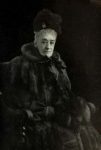 Following gifts totaling more than $160,000 between 1907-1909, the Teachers College is named for benefactor Margaret Olivia Slocum, a philanthropist, former teacher, and wife of financier Russel Sage.
Following gifts totaling more than $160,000 between 1907-1909, the Teachers College is named for benefactor Margaret Olivia Slocum, a philanthropist, former teacher, and wife of financier Russel Sage.
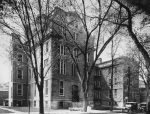 The Hospital of the Good Shepherd (now Huntington Hall) is purchased by Syracuse University to be a part of their College of Medicine. Among the 20 oldest hospitals in the United States, it was the first in the nation to offer nursing education, along with Johns Hopkins, in 1885. The Hospital was originally founded in 1872 under Bishop Frederic D. Huntington.
The Hospital of the Good Shepherd (now Huntington Hall) is purchased by Syracuse University to be a part of their College of Medicine. Among the 20 oldest hospitals in the United States, it was the first in the nation to offer nursing education, along with Johns Hopkins, in 1885. The Hospital was originally founded in 1872 under Bishop Frederic D. Huntington.
The tenure of Dean Albert S. Hurst sees “the beginning of student practice teaching, outside the city at first, in small schools such as Warners … [then with] willing cooperation from the city system.” It is believed that the Teachers College was the first of its kind to provide its students with practice teaching in public schools.
Among milestones in the tenure of Dean Harry S. Ganders were the establishment of the Alpha Delta Iota Chapter of Phi Delta Kappa, School Board Institute, Bureau of School Services, and Teachers Placement Bureau.
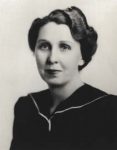 The Student Dean Program is inaugurated by Dean of Women Eugenie A. Leonard, to train women to become educational leaders. It is led by Dean Eunice Hilton from 1935 to 1959. The program later becomes co-educational and evolves into SOE’s Higher Education program.
The Student Dean Program is inaugurated by Dean of Women Eugenie A. Leonard, to train women to become educational leaders. It is led by Dean Eunice Hilton from 1935 to 1959. The program later becomes co-educational and evolves into SOE’s Higher Education program.
The new SOE incorporates the existing Teachers College, institutes dual professorships, and serves the University at large with both educational opportunities for faculty and staff and training in higher education administration. The new School begins to offer a Doctor of Education (Ed.D.) degree, after launching its first doctoral program two years prior. The Reading Center is soon inaugurated.
Progenitor to the Counseling and Human Services program, the Department of Guidance is established. A master’s degree in Guidance is initially offered.
The School of Education moves to Slocum Hall on the University hill.
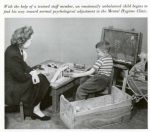 The Department of Education for Exceptional Children is established, a pioneering special education program.
The Department of Education for Exceptional Children is established, a pioneering special education program.The Department’s founding saw Syracuse become the first university to offer a full range of degrees—undergraduate through doctoral—for teachers of special education. Among opportunities for students are the Laboratory for the Handicapped, a Psychological Center, a Hearing and Speech Clinic, and the local Percy Hughes School (a Syracuse district facility for children with special needs, opened in 1930 and closed in 2021).
The Bureau of School Service is created, administering off-campus courses and direct services to school systems.
With SOE offering audio-visual services for the entire University as early as 1943, the Audio-Visual Center is formed, a progenitor of the Instructional Design, Development, and Evaluation program.
SOE creates one of the nation’s first graduate programs in instructional technology, called Audio-Visual Education.
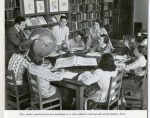 Consolidating SOE’s several literacy programs, the Reading and Language Arts program is formed, one of the oldest programs in the nation dedicated to literacy education.
Consolidating SOE’s several literacy programs, the Reading and Language Arts program is formed, one of the oldest programs in the nation dedicated to literacy education.
 The University opens the Hoople Center for Special Education Building on Irving Avenue, one of five such buildings on a university campus in the nation.
The University opens the Hoople Center for Special Education Building on Irving Avenue, one of five such buildings on a university campus in the nation.Hoople is home to the Division of Special Education and later the Gebbie Clinic, Center on Human Policy, and Taishoff Center for Inclusive Higher Education. Hoople’s original location is now the site of the National Veterans Resource Center.
SOE is first accredited by the National Council for Accreditation of Teacher Education.
University Hospital of the Good Shepherd patients are transferred to the new State University Upstate Medical Center Hospital (now Upstate Medical University).The hospital building is converted to academic use and re-named Huntington Hall, after the Rt. Rev. Frederick D. Huntington, former Episcopal Bishop of the Diocese of Central New York, the hospital’s founder.
 Professor Burton Blatt’s groundbreaking book Christmas in Purgatory: A Photographic Essay on Mental Retardation is published, described as “a classic photo essay of legally sanctioned human abuse in state institutions.” Professor Blatt joins the School of Education faculty in 1969.
Professor Burton Blatt’s groundbreaking book Christmas in Purgatory: A Photographic Essay on Mental Retardation is published, described as “a classic photo essay of legally sanctioned human abuse in state institutions.” Professor Blatt joins the School of Education faculty in 1969.
Professor Peter Knoblock co-founds Syracuse’s Jowonio School, a leader in inclusive schooling. Starting as a higher grades alternative before becoming a pre-school in 1977, the school maintains a close relationship with SOE to this day.
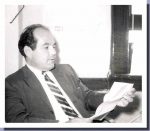 The Center on Human Policy is founded by Dean Burton Blatt in response to widespread discrimination against people with disabilities in society. It is the “first national institute for the study and creation of open, inclusion settings."
The Center on Human Policy is founded by Dean Burton Blatt in response to widespread discrimination against people with disabilities in society. It is the “first national institute for the study and creation of open, inclusion settings." Blatt testifies in the landmark Pennsylvania Association for Retarded Children (PARC) v. Commonwealth of Pennsylvania case, the first right-to-education suit in the nation and fundamental to establishing a national policy recognizing the educational ability of all children.
The same year, The Central New York School Study Council (aka The Study Council) is formed, and the Center for Instructional Communications becomes the Center for Instructional Development, which controls the University’s campus audiovisual, photography, film library, graphic arts, and motion picture production units.
Syracuse University Project Advance begins, as a project of the Center for Instructional Development, training high school teachers as SU adjunct professors to offer advanced placement SU classes in their schools.
The Gebbie Speech, Language, and Hearing Clinic opens in the Hoople Building .
Professor Douglas Biklen and the College of Law’s Professor Richard Ellison sue Syracuse City School District to admit children with disabilities.
The School of Education completes its move to Huntington Hall.
Professor Don Ely launches the ERIC Clearinghouse on Information Resources at Syracuse University, one of 16 federally funded clearinghouses serving K-12 education. The next year, the Area of Instructional Technology becomes the Department of Instructional Design, Development, and Evaluation.
The Association of Teacher Educators recognizes SOE as a “Distinguished Program for Teacher Education.”
With assistance from SOE, Edward Smith Elementary School in the Syracuse City School District begins to fully include children with autism into its classrooms, a national first.
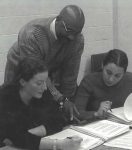 Columbus “Ted” Grace G’99, G’02, creates the Grace Children's Academy, Syracuse’s first African American pre-school, along with his wife, Jackie.
Columbus “Ted” Grace G’99, G’02, creates the Grace Children's Academy, Syracuse’s first African American pre-school, along with his wife, Jackie.Later an SOE literacy professor, Grace passed suddenly at home in 2004. Corcoran High School in the Syracuse City School District memorializes him with its Ted Grace Reading Grove (2009).
The Center on Human Policy begins a National Institute of Education-funded study on “exemplary mainstreamed classes” with 25 Syracuse-area programs chosen for study.
SOE’s first six-credit study abroad trip (New Perspective: Special Education and Rehabilitation) to Italy takes place, to study mainstreaming and inclusive education in that nation, organized by Carol Berrigan.
SOE receives a $3.7 million grant from The Kellogg Foundation for “optical disc technology” to store adult and continuing education resources and make them available nationwide (aka The Kellogg Project).
The Center on Human Policy receives $1.7 million from the National Institute on Handicapped Research to establish a Training Center on Community Integration.
Master’s programs in School Counseling and Student Affairs Counseling and the doctoral program in Counselor Education receive CACREP national accreditation.
Professor Dan Lortie of the University of Chicago is the first speaker in the Harry S. and Elva K. Ganders Lecture Series, establishing the year prior by Phyllis Ganders Seibel and Joan Ganders Glassey in memory of their parents.
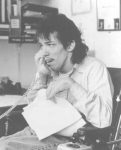 The first national documentary on school inclusion—Regular Lives—is aired on PBS, produced by Professor Douglas Biklen. It wins numerous awards, including a Blue Ribbon from the American Film Institute.
The first national documentary on school inclusion—Regular Lives—is aired on PBS, produced by Professor Douglas Biklen. It wins numerous awards, including a Blue Ribbon from the American Film Institute.The same year, SOE’s Liberty Partnership Program begins, a New York State Education Department initiative to address the dropout rate among Syracuse youth and to foster student success at the secondary and post-secondary levels. The School of Education later becomes home to multiple academic opportunity programs for both K-12 and higher education students under the Center for Academic Achievement and Student Development.
The Department of Cultural Foundations of Education is formed.
This program was designed to meet the academic requirements for New York State teacher certification in both Childhood Education and Students with Disabilities. Inclusive Elementary and Special Education makes Syracuse, according to Program Director Luanna Meyer, the “only college in the country to [fully] combine elementary and special education programs.”
The Facilitated Communication Institute opens, to study and promote communication by people with autism and other developmental disabilities. It is later renamed to the Institute for Communication and Inclusion, and then Inclusion and Communication Initiatives.
The Counselor Education and Rehabilitation Counseling departments merge to form the Department of Counseling and Human Services.
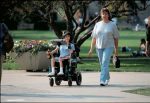 SOE establishes a graduate Disability Studies program, the first in the nation.
SOE establishes a graduate Disability Studies program, the first in the nation.The program examines a range of issues confronting people with disabilities, including race, gender, policy, law, the media, and cultural representations of disability. In 2000, a 15-credit Disability Studies CAS program was added, and in 2010 an 18-credit Disability Studies minor was added.
The Cultural Foundations of Education department begins the federally funded Syracuse University Violence Prevention Project. Principal investigators are Professor Joan Burstyn (Dean, 1985-1989) and Professor Steven J. Taylor.
‘Cuse in Kenya begins with a memorandum of understanding between SU and Kenyatta University, where Professor (Later Dean) Joanna Masingila was a Fulbright Scholar.
Furthering its work on rehabilitation, under Professor Steven J. Taylor the Center on Human Policy receives a five-year, $2 million National Institute on Disability and Rehabilitation grant to promote supported living and choice nationwide.
The SOE Board of Visitors (now called the Advisory Board) convenes for the first time.
SOE is awarded a $1.4 million federal grant for “Content in Action: Preparing Today’s and Tomorrow’s Teachers to Use Technology,” led by professors John Tillotson and Patricia Tinto.
The Education Living Learning Community is launched, providing education undergraduates with a campus affinity and student success support group. In 2024, the ELLC is renamed The HIVE (Home for Inclusive and Visionary Educators).
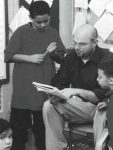 Bridge to the City, an immersive teacher preparation field experience program in New York City, is launched.
Bridge to the City, an immersive teacher preparation field experience program in New York City, is launched.Growing from a Meredith Professorship project by Professor Gerald Mager, the program brings students to NYC for a full semester of teaching and courses.
New York State approves SU’s joint degree program in law (J.D.) and education (M.S.) in Disability Studies, the first such program in the nation.
CNN broadcasts the documentary Autism is a World, co-produced by Professor Douglas Biklen. It is nominated for an Academy Award.
SOE announces the launch of the Holocaust and Genocide Initiative, including the Spector/Warren Fellowship for Future Educators and Zeiring Continuing Education Certificate, led by Professor Alan Goldberg.
The Partnership for Better Education is launched, a preK-16 “testing ground” collaboration with the Syracuse City School District. Among the projects of this initiative are Schools of Promise, in partnership with Syracuse City School District, to establish a replicable model for school inclusion; the Adolescent Literacy Project; and the Enhanced Reading Opportunities program.
Professor Benjamin Dotger receives a Spencer Foundation grant to design a “standardized parent” conferencing model for training teachers, the beginning of the clinical simulations teaching model for pre-service teachers and other professionals continued today by the Center for Experiential Pedagogy and Practice.
Professor Gretchen Lopez begins the Intergroup Dialogue Program, a social justice initiative that facilitates communication across social, cultural, and power differences, part of the national Multi-University Intergroup Dialogue Research Project.
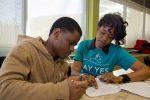 The Syracuse chapter of Say Yes to Education is created, designed to help urban youth find college success.
The Syracuse chapter of Say Yes to Education is created, designed to help urban youth find college success. Funded by Say Yes to Education Inc., it is the largest educational and economic development program of its kind in the nation.
The Syracuse chapter of Say Yes to Education is created, designed to help urban youth find college success. Funded by Say Yes to Education Inc., it is the largest educational and economic development program of its kind in the nation.
Reading and Language Arts Professor Marcelle Haddix launches Writing Our Lives, a literacy, writing, and arts program for Syracuse area youth.
SOE establishes the Lawrence B. Taishoff Center for Inclusive Higher Education to promote the participation of students with intellectual and developmental disabilities in postsecondary education, funded by the Taishoff Family Foundation. Among its signature projects are InclusiveU and OnCampus, a partnership with the Syracuse City School District to bring students to campus for academic, personal, and social development.
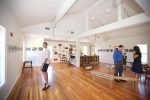 601 Tully, a center for co-production of culture in Syracuse Near Westside Neighborhood, opens in cooperation with the SOE.
601 Tully, a center for co-production of culture in Syracuse Near Westside Neighborhood, opens in cooperation with the SOE.
SOE signs its first Memorandum of Understanding with East China Normal University in Shanghai, China. The agreement includes academic collaboration on instructional design topics, hosting of ECNU students, and co-hosting of conferences.
A Huntington Hall renovation re-establishes the building’s main entrance on Marshall Street, iron gates are removed, and in May, the Sharon H. Jacquet ’72 Education Commons is dedicated.
SOE receives a $1 million gift from the Himan Brown Charitable Trust to support study abroad.
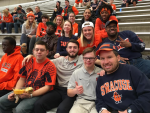 An initiative of the Taishoff Center led by Professor Beth Myers, InclusiveU brings students of all ages with intellectual and developmental disabilities who want to experience college life in a fully inclusive setting to Syracuse University.
An initiative of the Taishoff Center led by Professor Beth Myers, InclusiveU brings students of all ages with intellectual and developmental disabilities who want to experience college life in a fully inclusive setting to Syracuse University.
The Lender Center for Social Justice is opened, with a gift from Marvin ’63 and Helaine Gold Lender ’65, originally co-directed by SOE’s Professor Marcelle Haddix and Professor Kendall Phillips of the College of Visual and Performing Arts.
SOE, the Institute for Veterans and Military Families, and US Army collaborate to bring an online instructional design master’s degree program to the US Army Sergeants Major Academy at Ft. Bliss, CO.
The Syracuse chapter of the AACTE Holmes Scholars Program is created. Orange Holmes Scholars are first- or second- year doctoral students interested in teacher, leader, or counselor education.
The Center on Disability and Inclusion is formed, housing SOE’s disability and inclusion centers and initiatives, including the Taishoff Center for Inclusive Higher Education, InclusiveU, Center on Human Policy, Inclusion and Communication Initiatives, Mid-State Partnership, and Pre-Employment Transition Services. It is led by Professor Christy Ashby.
A Ben ’84 and Marcia Baldanza ’86 gift to SOE and the Maxwell School of Citizenship and Public Affairs launches the Baldanza Fund for Excellence in Education, which encourages teacher recruitment and retention in Syracuse area schools.
Intelligence++—an interdisciplinary initiative focused on inclusive entrepreneurship, design, and community—is created as a collaboration among InclusiveU, Blackstone LaunchPad at Syracuse Libraries, and College of Visual and Performing Arts School of Design.
In March, the Center for Experiential Pedagogy and Practice is founded, led by Professor Benjamin Dotger. CEPP engages in research and design initiatives to advance experiential teaching, learning, and professional development for educators and other professionals.
In October, the School of Education Assembly voting members agree to de-departmentalize, part of a comprehensive “One School” re-design that focuses on three signature areas of scholarship: Inclusive Pedagogy and Practice, Digital Pedagogy and Practice, and Experiential Pedagogy and Practice. This effort is catalyzed with a call to action by the Faculty for Racial Justice and Equity (FREE) collective.
Under Principal Investigator Julia M. White, SOE is awarded a $1.14 million US Department of Education grant for Project IMPRESS (Interdisciplinary Master’s Preparation of Urban and Rural Educators in Special Education and School Counseling) to recruit professionals for high-needs school districts.
SOE joins a $25M USAID-funded project led by not-for-profit development group Creative, focused on developing inclusive and equitable early grade education in Uzbekistan.
SOE is awarded a $3.7 million grant from the US Department of Education Office of Special Education and Rehabilitative Services to prepare up to 14 doctoral-level special education professors and educational leaders.
The Himan Brown Fellowship program becomes the Corinne R. Smith Study Abroad Program Fund, thanks to a gift from Lynn H. Smith, Professor Smith’s husband.
New York State Education Department approves revisions to SOE’s undergraduate teacher preparation degree programs. Beginning in fall 2024, the School offers two inclusive undergraduate degree options: Inclusive Childhood Education and Inclusive Adolescent Education. Continuing its groundbreaking history in inclusive education, SOE is among the very first teacher colleges in the nation to offer a dual certification adolescent teacher preparation program.
An anonymous benefactor gives $150,000 to SOE to provide scholarships for Native American students preparing to become inclusive education teachers. The School of Education Indigenous Teacher Preparation Fund provides scholarships to at least seven undergraduate students in its first cohort, matriculating by the 2026-2027 academic year.
With the reorganization of the Falk College of Sport and Human Dynamics, Syracuse University announces that the School of Social Work will be housed with SOE after July 2025.
The Taishoff Family Foundation gifts $2.5 million to inclusive higher education at Syracuse University, helping to strengthen the Center on Disability and Inclusion, Taishoff Center, and InclusiveU.
